Better playground design could help kids get more exercise
Designs that encourage imaginative play and keep kids off the sidelines make a difference
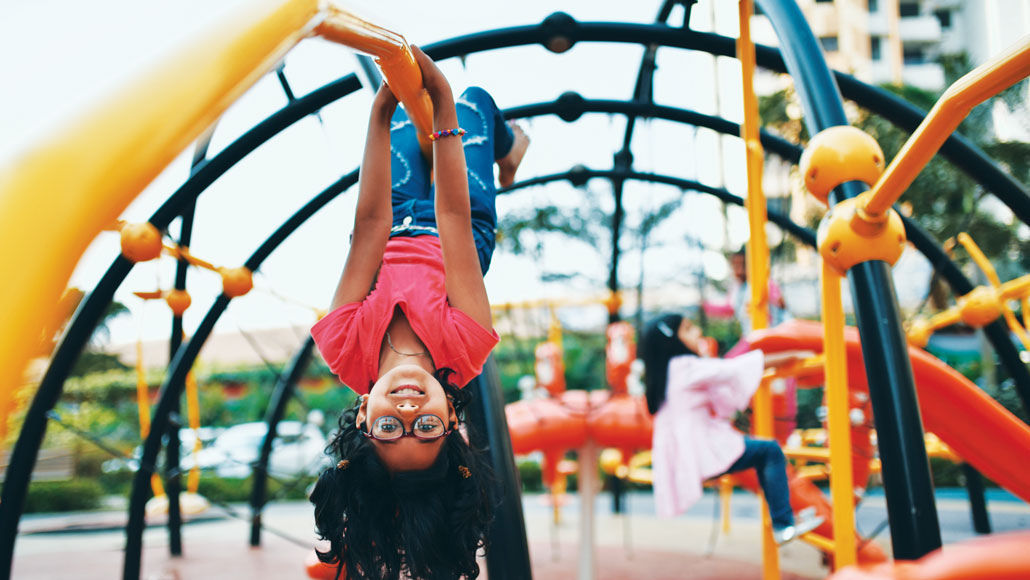
Playgrounds with engaging equipment and areas for imaginative play boost activity.
Mayur Kakade/Getty Images
The playground at Lake County Intermediate School in Leadville, Colo., was in desperate need of a makeover. The schoolyard didn’t offer much — just a few swings, some rusty climbing equipment, a cracked basketball court and a play area of dirt and gravel.
In the spring of 2014, the community replaced the run-down equipment, installing a spider web–like climbing net, twisting slides and colorful swings. A new basketball court went in, along with a grassy play area and walking paths. Kids got access to balls, Hula-Hoops and other loose equipment.
The overhaul did more than improve how the playground looked; it turbocharged the kids’ recess activity. When researchers observed the playground that November, they found that the share of children participating in vigorous physical activity had tripled. And the changes appeared to last — a year after the overhaul, the students were still more active than they’d been before, the researchers reported in 2018 in the American Journal of Preventive Medicine.
“A lot of things, when they’re new and shiny, lead to increased physical activity, but it’s not always sustained,” says Elena Kuo, a senior evaluation and learning consultant at Kaiser Permanente Washington Health Research Institute in Seattle, who coauthored the study. “That’s why it’s a pretty exciting finding.”
Behavior change
After the Lake County Intermediate School in Leadville, Colo., transformed its mostly barren schoolyard into a colorful, active playground, fewer fifth- and sixth-graders were sedentary and more were vigorously active (running, climbing or in fast-paced action) during recess at both six and 12 months after the redesign .
How a playground redesign changed student activity

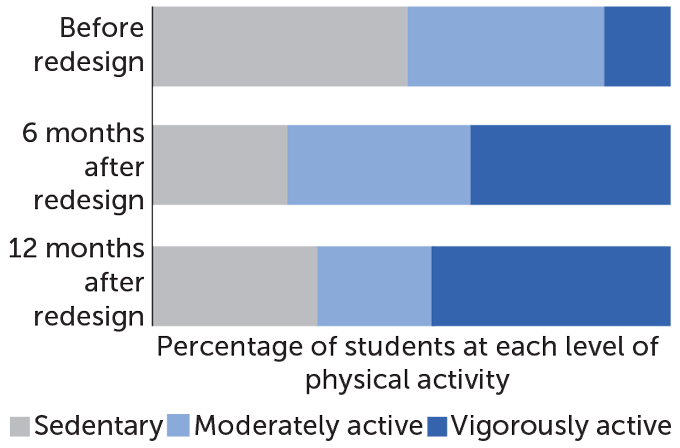
Source: M.C. Frost et al/Am. J. Prev. Med. 2018
Being physically active has many benefits for kids: It reduces obesity risk and improves overall physical and mental health, fosters social and emotional development and boosts academic performance. The World Health Organization recommends that schoolchildren get 60 minutes of moderate to vigorous activity every day. Most kids fall far short of that goal. Globally, 81 percent of 11- to 17-year-olds fail to hit that threshold, according to an analysis reported in January in the Lancet.
Playgrounds offer a chance to encourage kids to be more active in their everyday lives. “You’ve got a captive audience and a lot of kids,” says Kuo, calling outdoor play areas “an opportunity to have a high impact.” Overhauling playgrounds to encourage active play is gaining momentum, she says.
Scientists across the globe are studying how to maximize the opportunity that playgrounds provide. Research teams are using accelerometers, GPS tags and other wearable technology to probe how kids behave on playgrounds and are conducting randomized controlled trials to assess whether certain playground features, programs and designs can encourage kids to move more.

The results so far suggest that there are ways to subtly nudge children into being more active on playgrounds. And scientists say that there’s now enough evidence to begin making some specific recommendations to cities and schools that want to create playgrounds that foster movement. “When they come to us, we are now able to give them some pointers,” says Jasper Schipperijn, a sports scientist at the University of Southern Denmark in Odense.
While “evidence-based” playgrounds and playground-based programs won’t be a cure-all, they could make a real difference for some kids. “You’ll have children that will be active regardless of how their school or playground looks,” Schipperijn says. “But then there’s another group of kids that needs a bit more help.”

Trustworthy journalism comes at a price.
Scientists and journalists share a core belief in questioning, observing and verifying to reach the truth. Science News reports on crucial research and discovery across science disciplines. We need your financial support to make it happen – every contribution makes a difference.
Sparking play
By the time Leadville embarked on its playground renovation, scientists had already identified several strategies for boosting playground activity. One of the first interventions to amass considerable research support used nothing more than some cans of colorful paint.
In the late 1990s, Gareth Stratton, a sports and exercise scientist then at Liverpool John Moores University in England, launched a pilot study at a local primary school. Stratton worked with the young students to develop a set of fun, brightly colored designs — including a castle, pirate ship, dragon, clockface, hopscotch board and maze — to paint on the playground surface.
The markings seemed to spark active, imaginative play and changed how students used the space, reducing the dominance of soccer and creating new play areas and opportunities for kids who might otherwise just opt out, says Stratton, now at Swansea University in Wales. “There’s no sitting on the sidelines anymore because there aren’t sidelines as such.”
When Stratton attached heart monitors to 36 of the schoolchildren, he discovered another benefit of the markings. During the month before markings were added, kids spent an average of 27 minutes of their daily recess time — which totaled about an hour a day, divided into three play sessions — engaged in moderate to vigorous physical activity, he reported in 2000 in Ergonomics. In the month after the designs were painted, that number jumped to 45 minutes a day. The children’s playtime heart rates also increased by an average of seven beats per minute. (The activity of children at a nearby school without the markings increased more modestly over the study period, from 29 minutes to 36, and there was almost no change in their heart rates.)

In the years since, Stratton and other researchers have confirmed and expanded upon these findings — and schools have put the lessons into practice. “This is something that’s actually had traction and is actually really useful in a real-world setting,” Stratton says.
In addition to playground markings, loose play equipment, like the balls and Hula-Hoops added at Leadville, can encourage kids to move more. Two studies published in 2019 in the Journal of School Health used a popular observational tool known as the System for Observing Play and Leisure Activity in Youth, or SOPLAY, to demonstrate the power of these supplies. To use SOPLAY, researchers systematically scan the play area, counting the number of children who are sitting, walking or engaged in higher-intensity pursuits.
In the first study, the proportion of students engaged in moderate to vigorous physical activity at 19 schools in Los Angeles County was roughly 10 to 20 percentage points higher in play areas with loose equipment.
The second study, based in two school districts in Colorado, demonstrated that the more play equipment schools provided, the bigger the activity gains.
“If there’s something fun to do, kids will do it,” Kuo says. “Even something as simple as having a bunch of balls available and having Frisbees around — it’s just more fun than a random open field.”
Unconventional equipment
And the options go beyond traditional sports equipment. For Australia’s Sydney Playground Project, which began in 2009, researchers enrolled 12 inner-city primary schools and randomly assigned half to receive a two-part intervention.
The playgrounds at the intervention schools were stocked with an assortment of recycled “loose parts” — hay bales, tires, crates and foam pool noodles. “We just put them on the playground with no instruction to the children about what you should do with them, and we asked the adults to try to step back from the children and let them do whatever they wanted,” says Anita Bundy, a play researcher who led the Sydney Playground Project at the University of Sydney. (She has since moved to Colorado State University in Fort Collins.)
To encourage adults to keep their distance, Bundy and colleagues put parents, teachers and school staff through “risk reframing” workshops designed to reinforce the idea that active, independent free play — even seemingly dangerous kinds of play, such as climbing trees or running down hills — has myriad benefits for kids.
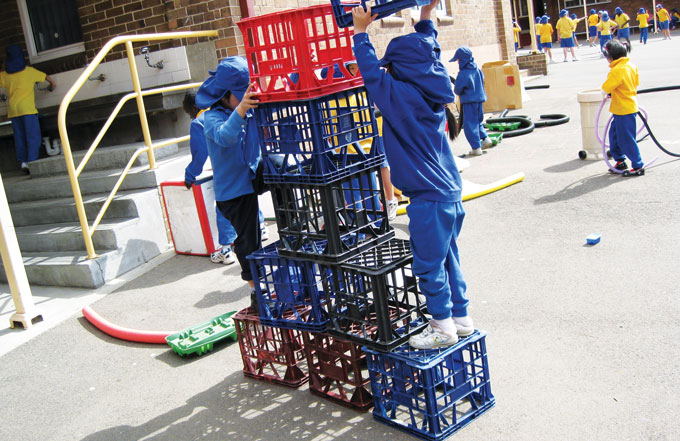
The intervention was a hit. Many teachers and parents reported that the workshops gave them a new perspective on potentially perilous play, and the kids embraced the strange playground supplies. The children combined and recombined those materials “in zillions of different ways, and they loved that,” Bundy says. At one school, some kids created an imaginary amusement park with the loose parts. At another, students invented new sports. “They’d have a whole team full of people playing pool noodle hockey,” Bundy says.
Indeed, an in-depth analysis of one Sydney primary school revealed that the loose parts prompted kids to play more than they had before and to engage in more creative play and a wider variety of activities, the researchers reported in 2018 in the Journal of Adventure Education and Outdoor Learning.
In a separate analysis, Bundy and colleagues tracked students’ activity levels using accelerometers fastened to the kids’ clothes. After the intervention, students at the experimental schools spent 12 percent more recess time participating in moderate to vigorous physical activity than children at the control schools, the researchers reported in 2013 in Preventive Medicine.
However, the absolute increases were modest. The amount of time that kids at the intervention schools spent engaged in moderate to vigorous physical activity increased by just two minutes, on average. It’s possible that the data from the accelerometers — which are better at picking up on when children start running than on the lifting, pushing, pulling, climbing and building that many of the kids were engaged in — underestimated the benefits of the loose materials.
But the results also highlight the limitations of relying on playgrounds as the singular secret to better child health. Recess tends to be short, and even “successful” interventions often add just a few extra minutes of activity to kids’ days.
So some experts caution that while creating more active, appealing playgrounds may be a step in the right direction, getting kids to move more requires a multipronged approach. “I wouldn’t put all my eggs in that basket,” says Mark Tremblay, who directs the Healthy Active Living and Obesity research group at the Children’s Hospital of Eastern Ontario Research Institute in Ottawa. Playgrounds, he says, are “one option, and I think there needs to be many, many options.”
Sign up for our newsletter
We summarize the week's scientific breakthroughs every Thursday.
Playground researchers argue that even small increases in activity matter, that a few extra minutes a day add up. “Is it enough? No it’s not, but it’s definitely a good step along the way,” says Schipperijn, in Denmark.
And studies, which tend to report averages, might miss positive effects. A playground overhaul may prompt some kids to be much more active while having no effect whatsoever on others. “The chances that it will work for all children is very small,” Schipperijn says. “Simply because different children need different things.”
Though individual kids vary enormously, in general, boys tend to be more active than girls. Schipperijn’s research suggests that at least some of the gender difference results from a social hierarchy in which boys tend to claim the most desirable amenities. Providing more play spaces could boost girls’ participation.
Varied landscapes
Different kids are also attracted to different activities, so it’s important to provide not just plenty of play spaces, but also varied ones.
In a study published in November 2019 in Landscape and Urban Planning, Schipperijn tracked students at three Danish schools before and after major playground renovations. Though each renovation was unique, in all three cases, the paved, mostly featureless schoolyards were converted into rich and varied playscapes. Each had some combination of sports courts, swings, four square and hopscotch markings, climbing structures, balance bars, trampolines, an obstacle trail, a climbing wall, hills, tree stumps and dedicated dancing areas with mirrors, loudspeakers and video screens. After the redesigns, there were more physical activity “hot spots” — for both boys and girls — than before, the researchers found.
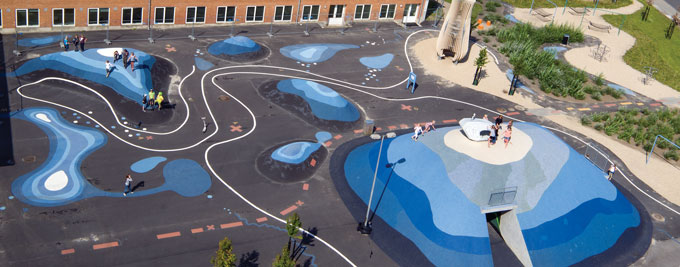
More structured play programs could also help pull the most sedentary kids into the action. That’s what researchers have found in studies of Playworks, a nonprofit that sends full-time coaches into low-income American schools to organize group games and activities during recess.
Researchers studied the effects of the program in various demographic groups in a randomized controlled trial that enrolled 29 schools spread across six American cities. Seventeen of the schools were randomly assigned to receive Playworks, while the other 12 schools served as controls. In the control group, black students spent an average of 14.1 percent of their recess time engaged in moderate to vigorous physical activity, while white students spent 19.2 percent of recess being similarly active.
Playworks appeared to close this gap, prompting black students to spend 20.4 percent of recess in moderate to vigorous physical activity, while the activity levels of white students remained essentially steady, at 19.7 percent, scientists reported in 2016 in the Journal of Physical Activity and Health. In a separate study, researchers also discovered that Playworks prompted girls, but not boys, to move substantially more.
The program may have leveled the proverbial playing field, making it easier for less active kids to participate in schoolyard games. “The Playworks coaches … were equally getting everyone involved and teaching kids games at the same time,” says Martha Bleeker, a senior researcher involved in both studies at the policy research firm Mathematica. “It’s not like one group had ownership over that activity.”
It’s also possible that any effort to remake playgrounds yields the biggest dividends for the kids who are the least active, and who thus have the most room for improvement.
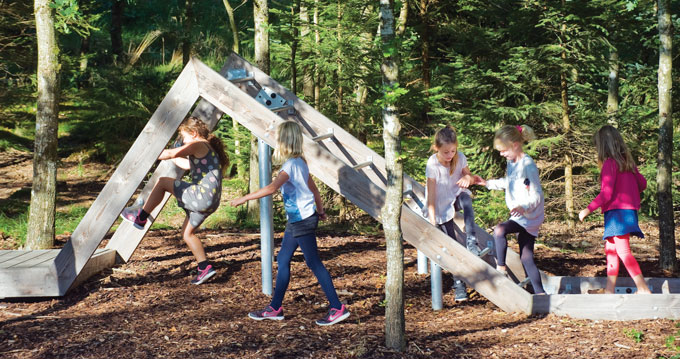
To get the most out of playground redesigns and programs, schools may also need to rethink certain practices and policies. In many schools in Australia, for instance, kids aren’t allowed to play at recess if they don’t have a hat to protect them from the blazing sun, says Anne-Maree Parrish, a childhood physical activity researcher at Australia’s University of Wollongong.
In a randomized controlled trial published in 2016 in the Journal of Science and Medicine in Sport, Parrish found that providing loose play equipment alongside policy changes, including one that allowed hatless kids to play in the shade, boosted the share of break time that students spent in moderate to vigorous physical activity by 9 to 13 percentage points.
And even the best-designed playgrounds won’t make much difference if kids don’t get time to play on them. Although the share of U.S. school districts that mandate regular recess for elementary school students is up from 46 percent in 2000 to 65 percent in 2016, the average amount of daily recess time has actually ticked down slightly, from 30 minutes in 2000 to 27 in 2014.
“The biggest challenge at the moment is that time allocated to recess and lunchtime is decreasing in schools,” says Nicola Ridgers, a researcher at the Institute for Physical Activity and Nutrition at Deakin University in Australia. “So it’s really [about] trying to protect that time and make sure that kids have the opportunity to play.”
While playgrounds won’t single-handedly remedy the problem of childhood inactivity, they can be part of the solution — instilling a love of movement and setting the stage for a lifetime of healthy habits. As Parrish notes, “Any opportunity to try and increase their physical activity somewhere is always a bonus.”







